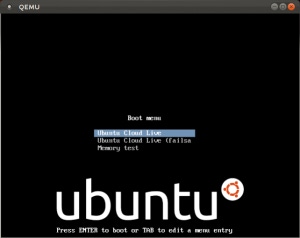
“The cloud” can be hard to visualize, not least because the hardware behind it is often an ambiguous collection of servers scattered somewhere across the ether of the Internet. But in Canonical’s vision, the cloud can be something as simple and concrete as a USB stick running the Ubuntu Cloud Live image, which makes the creation of private clouds quite trivial. I recently got a chance to play around with this neat tool, and here’s what I found.
The idea of creating a portable private cloud based on Ubuntu dates to “Cloud in your Pocket,” a live ISO based on Ubuntu 10.04 introduced by Dustin Kirkland at the Ubuntu Developer Summit conference in May 2010. A refined version was presented to attendees of the OpenStack conference last October, where Canonical gave away USB sticks preloaded with what was by then officially deemed Ubuntu Cloud Live.
Based in its most recent iteration on Ubuntu 11.10, Ubuntu Cloud Live — as its name implies — is a live session of Ubuntu preloaded with all the tools needed to create and manage a complete private cloud environment. It’s available as an image file that can be run on any computer from a USB stick (see here for instructions on creating a bootable USB stick using the image) or fired up quickly and easily in a virtual machine.
Test Driving Ubuntu Cloud Live
Eager to see what Ubuntu Cloud Live looks like, I downloaded the 530MB image and ran it in a KVM virtual machine. As promised, it booted quickly and easily to a simple Unity desktop offering a text editor, Chromium Web browser, terminal and little else in the way of graphical applications:


But Ubuntu Cloud Live is not about graphical glitz. The key to its power is in the “GettingStarted.txt” file on the desktop, which explains clearly, concisely and specifically what to do to finish configuring a private cloud via OpenStack Compute and then start launching instances, all inside the live session. I’m no OpenStack guru, but even I was able to get a personal private cloud up and running in a few minutes.
Why It Matters
Unlike other Linux “live” environments, which can be vitally helpful in a number of tricky situations such as rescuing a broken system, Ubuntu Cloud Live is probably of limited use for people actually setting up clouds. If that’s your goal you’re more likely to start with Ubuntu Server and build upward from there. After all, since the Ubuntu Cloud Live doesn’t even come with the Ubiquity installer, it’s not a practical means of building a permanent cloud on production hardware.
On the other hand, the tool is a fantastic way of showing off just how terrifically simple it is to create a private cloud using the applications and scripts produced by the Ubuntu cloud community. These tools all are available individually elsewhere — most of them are only on any modern Ubuntu system — but Ubuntu Cloud Live showcases them in a way that has real promise for cluing in even non-geeks about cloud computing, and why a private cloud might be a better fit than the alternatives.
And that’s important, since many people these days still don’t have a firm grasp of what the cloud really is or what it means in a concrete sense. With Ubuntu Cloud Live, one can literally hold the cloud in one’s palm and control it in a very hands-on way. It turns the cloud into something less nebulous, and that’s pretty cool.
About the Author(s)
You May Also Like


